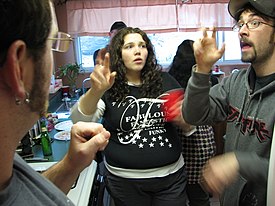Tuesday, 10 June 2014
Friday, 6 June 2014
Saturday, 1 February 2014
Tuesday, 28 January 2014
BRAILLE
Braille
This article is about the writing system used by the blind and the visually impaired. For other uses, see Braille (disambiguation).
| Braille |
|
|---|---|
 |
|
| Type | Alphabet (non-linear) |
| Languages | Several |
| Creator | Louis Braille |
| Time period | 1824 to the present |
| Parent systems |
Night writing
|
| Child systems | French Braille English Braille Bharati Braille Chinese Braille Japanese Braille Korean Braille etc. |
| Sister systems | New York Point |
| ISO 15924 | Brai, 570 |
| Direction | Left-to-right |
| Unicode alias | Braille |
| Unicode range | U+2800 to U+28FF |
| This article contains Unicode Braille characters. Without proper rendering support, you may see question marks, boxes, or other symbols instead of Braille characters. |
Listen to this article (info/dl)

Menu
0:00
This audio file was created from a revision of the "Braille" article dated 2006-09-06, and does not reflect subsequent edits to the article. (Audio help)
Braille is named after its creator, Frenchman Louis Braille, who went blind following a childhood accident. In 1824, at the age of 15, Braille developed his code for the French alphabet as an improvement on night writing. He published his system, which subsequently included musical notation, in 1829.[2] The second revision, published in 1837, was the first digital (binary) form of writing.
Braille characters are small rectangular blocks called cells that contain tiny palpable bumps called raised dots. The number and arrangement of these dots distinguish one character from another. Since the various braille alphabets originated as transcription codes of printed writing systems, the mappings (sets of character designations) vary from language to language. Furthermore, in English Braille there are three levels of encoding: Grade 1, a letter-by-letter transcription used for basic literacy; Grade 2, an addition of abbreviations and contractions; and Grade 3, various non-standardized personal shorthands.
Braille cells are not the only thing to appear in embossed text. There may be embossed illustrations and graphs, with the lines either solid or made of series of dots, arrows, bullets that are larger than braille dots, etc.
In the face of screen-reader software, braille usage has declined. However, braille education remains important for developing reading skills among blind and visually impaired children, and braille literacy correlates with higher employment rates.
Contents
History
Braille was based on a tactile military code called night writing, developed by Charles Barbier in response to Napoleon's demand for a means for soldiers to communicate silently at night and without light. In Barbier's system, sets of 12 embossed dots encoded 36 different sounds. It proved to be too difficult for soldiers to recognize by touch, and was rejected by the military. In 1821 Barbier visited the Royal Institute for the Blind in Paris, where he met Louis Braille. Braille identified two major defects of the code: first, by representing only sounds, the code was unable to render the orthography of the words; second, the human finger could not encompass the whole 12-dot symbol without moving, and so could not move rapidly from one symbol to another. Braille's solution was to use 6-dot cells and to assign a specific pattern to each letter of the alphabet.[3] At first, braille was a one-to-one transliteration of French orthography, but soon various abbreviations, contractions, and even logograms were developed, creating a system much more like shorthand.[4] The expanded English system, called Grade-2 Braille, was complete by 1905. For the blind today, braille is an independent writing system rather than a code of printed orthography.[5]SIGN LANGUAGE HISTORY
Sign language
This article is about primary sign languages of the deaf. For signed versions of oral languages, see manually coded language.
A sign language (also signed language or simply signing) is a language which uses manual communication and body language
to convey meaning, as opposed to acoustically conveyed sound patterns.
This can involve simultaneously combining hand shapes, orientation and
movement of the hands, arms or body, and facial expressions
to fluidly express a speaker's thoughts. They share many similarities
with spoken languages (sometimes called "oral languages", which depend
primarily on sound), which is why linguists consider both to be natural
languages, but there are also some significant differences between
signed and spoken languages.Wherever communities of deaf people exist, sign languages develop. Signing is also done by persons who can hear, but cannot physically speak. While they utilize space for grammar in a way that spoken languages do not, sign languages exhibit the same linguistic properties and use the same language faculty as do spoken languages.[1][2] Hundreds of sign languages are in use around the world and are at the cores of local deaf cultures. Some sign languages have obtained some form of legal recognition, while others have no status at all.
A common misconception is that all sign languages are the same worldwide or that sign language is international. Aside from the pidgin International Sign, each country generally has its own, native sign language, and some have more than one, though sign languages may share similarities to each other, whether in the same country or another one. No one knows how many sign languages there are; the 2013 edition of Ethnologue lists 137.[3]
Subscribe to:
Posts (Atom)





































